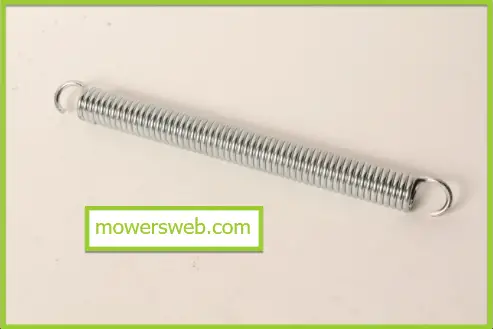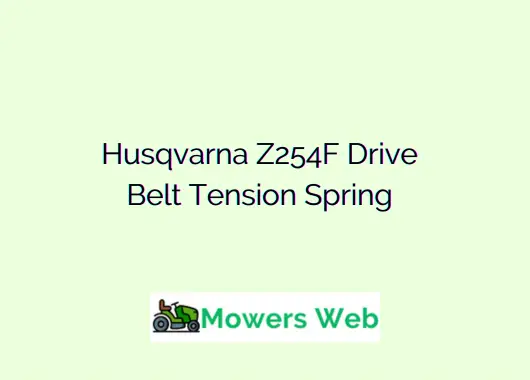The drive belt tension spring is a vital component in the Husqvarna Z254F zero-turn mower’s power transmission system.
It plays a crucial role in maintaining the appropriate tension of the drive belt, ensuring efficient power transfer between the engine and the cutting blades.
In this post, we will delve into the details of the Husqvarna Z254F drive belt tension spring, its function, maintenance tips, and common troubleshooting techniques.
So, let’s get started and ensure your mower operates smoothly and efficiently!

Husqvarna Z254F Drive Belt Tension Spring
Function of the Drive Belt Tension Spring
The drive belt tension spring exerts a force on the drive belt, keeping it properly tensioned.
By maintaining the correct tension, it prevents slippage or disengagement of the drive belt during operation.
This ensures that power from the engine is efficiently transferred to the cutting blades, resulting in smooth and precise mowing.
Signs of a Faulty Drive Belt Tension Spring
A worn-out or damaged drive belt tension spring can lead to various issues. Here are some signs that indicate a potential problem:
- Unusual noise or vibration from the mower deck
- Inconsistent or uneven cutting performance
- Excessive wear or damage to the drive belt
- Difficulty engaging or disengaging the blades
Read Where does the Spring go on a Mower Deck(Explained)
Maintenance Tips for the Drive Belt Tension Spring
To ensure the longevity and optimal performance of your Husqvarna Z254F drive belt tension spring, follow these maintenance tips:
- Regularly inspect the tension spring for signs of wear, such as cracks or deformation.
- Keep the tension spring clean and free from debris to prevent it from getting jammed or affecting its function.
- To reduce friction and lengthen the tension spring’s lifespan, lubricate it occasionally with a suitable lubricant Husqvarna has recommended.
Troubleshooting Common Drive Belt Tension Spring Issues
In case you encounter issues with the drive belt tension spring, here are some troubleshooting techniques you can try:
- Check the tension spring for any signs of damage and replace it if necessary.
- Verify that the drive belt is correctly routed and properly tensioned according to the manufacturer’s specifications.
- Inspect the tensioning mechanism for any obstructions or misalignments that may affect the tension spring’s operation.
Read Riding Mower Making Noise When Blades Are Engaged(Fixed)
Replacing the Drive Belt Tension Spring
If your drive belt tension spring is severely damaged or worn out, it may need to be replaced.
Here are the general steps to replace the tension spring:
- Consult the Husqvarna Z254F user manual for specific instructions and safety precautions.
- Locate the drive belt tension spring on the mower.
- Release the tension on the drive belt by following the recommended procedure.
- Remove the old tension spring by disconnecting it from its mounting points.
- Install the new tension spring and secure it properly.
- Follow the reverse procedure to reapply tension to the drive belt.
Read Husqvarna Anti Sway Rod Installation(In 3 Quick Steps)
How much tension should a mower deck belt have?
When it comes to the tension of a mower deck belt, it’s important to strike the right balance. The tension should neither be too loose nor too tight.
An optimal tension ensures proper power transmission and prevents slippage or damage to the belt.
To determine the correct tension for your mower deck belt, you can refer to the manufacturer’s guidelines or the user manual specific to your mower model.
These resources often provide detailed instructions on how to adjust and measure the tension accurately.
In general, a properly tensioned mower deck belt should have a slight amount of give when pressed with moderate pressure. You can check the tension by applying light pressure to the middle of the belt.
The belt should have some deflection or flexibility but not feel excessively loose or sagging. On the other hand, it should not feel overly tight or stretched.
Read 9 Common Husqvarna 445 Problems(With Solutions)
How do you tension a lawn mower belt?
Tensioning a lawn mower belt is an important maintenance task to ensure optimal performance and prevent belt slippage.
Here are the general steps to tension a lawn mower belt:
Preparation
Before starting, make sure the mower is turned off and the spark plug wire is disconnected to prevent accidental startup.
Locate the tensioning mechanism
Depending on your mower’s make and model, the tensioning mechanism may vary. It is typically found near the mower deck or engine pulley system.
Consult your mower’s user manual for specific guidance on locating the tensioning mechanism.
Loosen the tension
Most tensioning mechanisms involve a lever or adjustment bolt. Loosen the tension by either releasing the lever or loosening the adjustment bolt. This will relieve the tension on the belt and allow for adjustment.
Adjust the tension
Once the tension is loosened, you can adjust the tension of the belt. Some mowers have a specific measurement or indicator for proper tension, while others rely on visual and tactile inspection.
Read Husqvarna Weed Eater Won’t Stay Running(FIXED)
Proper tensioning
To tension the belt, either move the tensioning lever or tighten the adjustment bolt, depending on the type of tensioning mechanism.
Apply gradual tension until the belt feels firm but not overly tight. Avoid overtightening, as it can strain the belt and other components.
Check belt deflection
After tensioning, check the belt deflection. Press down gently on the belt with moderate pressure in the middle of the longest belt span.
The belt should have a slight amount of give but not be too loose or sagging. Adjust the tension as needed to achieve the proper deflection.
Secure the tension
Once the desired tension is achieved, secure the tensioning lever or tighten the adjustment bolt to hold the tension in place. Double-check the tension to ensure it remains within the recommended range.
Read Husqvarna 545 Mark II Reviews(Uncover the Secrets)
How does the drive belt go on a Husqvarna zero turn?
| Step | Procedure |
|---|---|
| 1 | Preparation: Ensure the mower is turned off, and the spark plug wire is disconnected to prevent accidental startup. Familiarize yourself with the layout of the mower deck and pulley system. |
| 2 | Locate the drive belt routing diagram: Husqvarna zero-turn mowers typically have a belt routing diagram displayed on the mower deck or in the user manual. Refer to this diagram for the correct path the drive belt should follow. |
| 3 | Loosen the tension: Locate the drive belt tensioning mechanism, usually a tensioner pulley or lever near the engine or mower deck. Loosen the tension to provide enough slack for installing the belt. Refer to the user manual for specific instructions on loosening the tension. |
| 4 | Remove the old belt (if applicable): If you are replacing an old belt, release the tension and carefully remove the old belt from the pulleys, following the belt routing diagram for reference. |
| 5 | Install the new belt: Start by placing the new drive belt onto the appropriate pulleys as indicated by the routing diagram. Begin with the engine pulley and work your way towards the mower deck pulleys, ensuring the belt fits securely into each pulley groove. |
| 6 | Route the belt correctly: Follow the belt routing diagram precisely, making sure the belt is properly seated in each pulley groove and aligned with the guides or idler pulleys along the way. Avoid any twists or misalignments that can cause the belt to slip or wear prematurely. |
| 7 | Apply tension to the belt: Once the belt is correctly routed, gradually tighten the tensioning mechanism to apply tension to the belt. Refer to the user manual for the recommended tensioning procedure specific to your Husqvarna zero-turn mower. |
| 8 | Verify proper installation: Double-check the belt’s alignment and ensure it sits properly in all pulley grooves. Confirm that there is adequate tension without over-tightening. |
| 9 | Test the mower: After the drive belt is installed, reconnect the spark plug wire, and start the mower. Engage the blades and observe their operation to ensure the belt functions smoothly and without any slippage or abnormal noise. |
Read How to Adjust Seat on Husqvarna Riding Mower(Easily)
FAQs
How often should I inspect the drive belt tension spring?
It is recommended to inspect the tension spring before each mowing season and periodically throughout the year to ensure its proper functioning.
Can I lubricate the drive belt tension spring with any type of lubricant?
No, it’s essential to use a lubricant that Husqvarna has specifically advised in order to avoid potential tension spring damage.
Can I adjust the tension of the drive belt manually?
Husqvarna Z254F mowers are equipped with an automatic tensioning system, and manual adjustment is not necessary.
Is it possible to replace the drive belt tension spring myself?
While it is possible to replace the tension spring yourself, it is recommended to refer to the user manual or seek professional assistance for proper installation.
How long does a typical drive belt tension spring last?
The lifespan of a tension spring can vary depending on usage and maintenance. However, with proper care, it should last several years.
Read What Size Mower for 10 Acres?(Tips for Perfect Size)
Final Remarks
The drive belt tension spring is an essential component of the Husqvarna Z254F zero-turn mower, ensuring smooth power transmission and efficient cutting performance.
By following the maintenance tips and troubleshooting techniques outlined in this post, you can keep your drive belt tension spring in optimal condition, extending its lifespan and maximizing the performance of your mower.
Now that you have a comprehensive understanding of the Husqvarna Z254F drive belt tension spring, you’re well-equipped to maintain and troubleshoot any potential issues that may arise.




